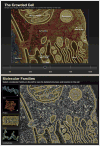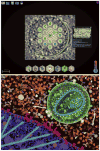From Atoms to Cells: Using Mesoscale Landscapes to Construct Visual Narratives
- PMID: 29885327
- PMCID: PMC6186495
- DOI: 10.1016/j.jmb.2018.06.009
From Atoms to Cells: Using Mesoscale Landscapes to Construct Visual Narratives
Abstract
Modeling and visualization of the cellular mesoscale, bridging the nanometer scale of molecules to the micrometer scale of cells, is being studied by an integrative approach. Data from structural biology, proteomics, and microscopy are combined to simulate the molecular structure of living cells. These cellular landscapes are used as research tools for hypothesis generation and testing, and to present visual narratives of the cellular context of molecular biology for dissemination, education, and outreach.
Keywords: cellular mesoscale; integrative structural biology; mesoscale modeling; molecular graphics; science education.
Copyright © 2018 Elsevier Ltd. All rights reserved.
Figures










References
-
- Alber F, Forster F, Korkin D, Topf M, Sali A. Integrating diverse data for structure determination of macromolecular assemblies. Annu Rev Biochem. 2008;77:443–477. - PubMed
-
- Ben-Harush K, Maimon T, Patla I, Villa E, Medalia O. Visualizing cellular processes at the molecular level by cryo-electron tomography. J Cell Sci. 2010;123:7–12. - PubMed
-
- Beck M, Baumeister W. Cryo-electron tomography: Can it reveal the molecular sociology of cells in atomic detail? Trends Cell Biol. 2016;26:825–837. - PubMed
-
- Porter KR, Tucker JB. The ground substance of the living cell. Sci Am. 1981;244:56–67. - PubMed
Publication types
MeSH terms
Grants and funding
LinkOut - more resources
Full Text Sources
Other Literature Sources

